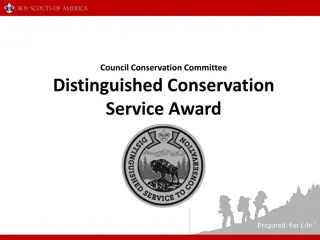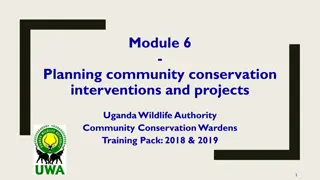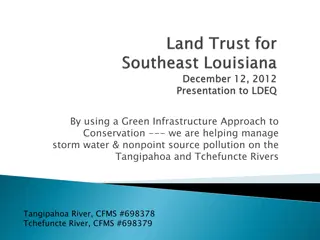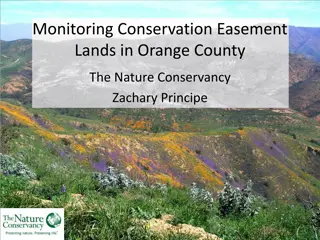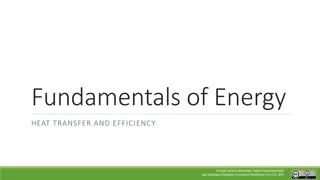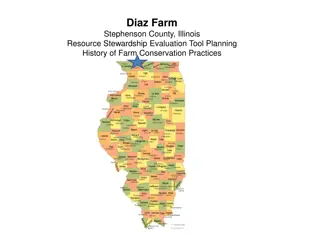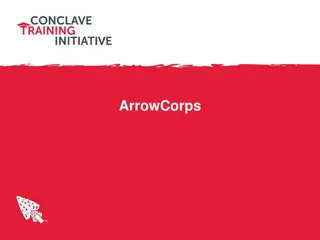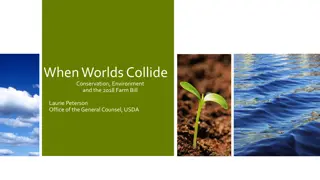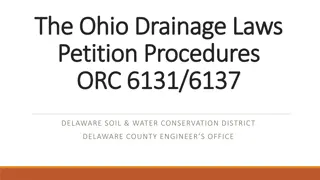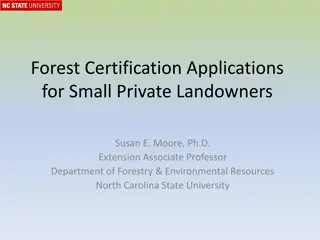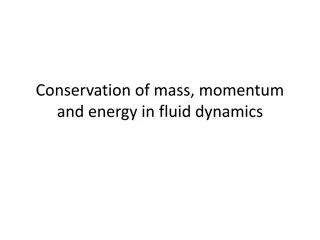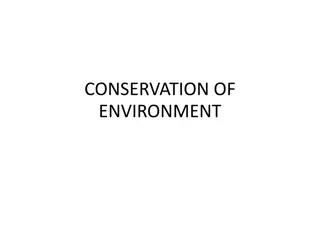Importance of Conservation Planning for Landowners
Conservation planning is crucial for landowners to ensure resource quality, animal health, compliance with regulations, and overall property value. Learn about the benefits, requirements, and history of conservation plans.
Uploaded on Feb 19, 2025 | 0 Views
Download Presentation

Please find below an Image/Link to download the presentation.
The content on the website is provided AS IS for your information and personal use only. It may not be sold, licensed, or shared on other websites without obtaining consent from the author.If you encounter any issues during the download, it is possible that the publisher has removed the file from their server.
You are allowed to download the files provided on this website for personal or commercial use, subject to the condition that they are used lawfully. All files are the property of their respective owners.
The content on the website is provided AS IS for your information and personal use only. It may not be sold, licensed, or shared on other websites without obtaining consent from the author.
E N D
Presentation Transcript
Conservation Planning Why and What? BENITA LITSON
Benefits of a Conservation Plan Required for the transfer of Navajo Nation Grazing Permits and Land Use Permits. Ensures improved natural resource quality for you, your animal and your neighbors Enhance open space and wildlife habitat Improves animal health Prevents off-site impacts, and may help you comply with environmental regulations Contributes to plant health and vigor Makes your land more attractive and promotes good neighbor relations Promotes health and safety for your family Saves money as your land becomes more productive Increase property value Helps you identify your eligibility for several USDA programs.
Why Conservation Plan There are two types of conservation plans required One is for the Navajo Nation Another for USDA programs such as Natural Resource Conservation Services Accountability Measure for you as a producer (farmer or rancher) Past Common Practice The BIA (Bureau of Indian Affair would sit down with you and create a conservation plan with you, very basic) Current Practice Individual ranchers are asked to submit a conservation plan for accountability measures What cause this change? 2014 The U.S. government paid $554 million due to a long standing claim to the US Gov. on mismanaged fund and natural resources on the Navajo Nation
History BIA and USDA Programs USDA Presence on Tribal Lands Established in 1929 through an Emergency Act of Congress in response to the Dust Bowl 1933 Soil Erosion Services 1935 Soil Conservation Services 1940 The Reorganization plan transferred certain conservation function to US Dept. of Interior (USDI) from USDA. This transfer was interpreted to prohibit NRCS from assisting Indian Landowners whose land was held in trust by USDI. 1970 Policy of the Bureau (BIA) to cooperate as closely with SCD (Soil Conservation Districts) as legally authority 1977 Indian Landowners whose land were included within boundaries of a Conservation District, SCS (Soil Conservation Services), may provide assistance for planning and implementing programs. In 1994 SCS name changed to Natural Resource Conservation Service (NRCS).
Program Outline and Appropriations Outline Farm Bill Every 5 years the Farm Bill expires and is updated Farm Bill Mandates and Appropriates Funds It is an extensive process debated and passed by congress and is then signed into law by the US President. State Farm Bill usually have a unique title The 2018 Farm Bill is Titled Agricultural Improvement Act of 2018 Soil and Water Conservation Districts District On through September 30, 2023 Conservationist
USDA Farm Bill Includes Commodity Programs Margin Protection Program for Dairy Conservation Conservation Reserve Program (FSA, NRCS, etc. ) Trade Borlaug Fellowship Foreign Ag Services, Local and regional food Aid Procurements, Agricultural trade Promotion Facilitation. Nutrition programs SNAP (Supplemental Nutrition Assistance Program), TEFAP (The Emergency Food Assistance Program), FDPIR (Food Distribution Program on Indian Reservations) , CSFP (Commodity Supplemental Food Program) Credit loan limits, and farm ownership loan Rural Development Cushion of credit, inter agency task force, economic devel. Research carry over funds for extension 1890 Land Grant Forestry- Good neighbor authority, tribal forest management demonstration, Energy Bioenergy, rural energy, Biorefinary Horticulture biostimulants, Farmers market, Hemp Crop Insurance Forage and Standard Reinsurance Agreement Miscellaneous Tribal Consultation, Pima Cotton Trust, Wool Trust, Dairy Business, Sheep Production and Marketing Grant, Feasibility Study on Livestock Dealer , Veteran Farmer and Rancher.
Soil and Water Conservation Districts SWCD Navajo Nation SWCD Like a county of school district, it is a subdivision of state government. Little Colorado River Navajo Mountain SWCD is brought into existence by a vote of the landowners or user within boundaries of a district Chinle San Juan River Fort Defiance On the Navajo Nation SWCD established under Tribal Resolution CF-11-80-2/7/80 Each NN chapter should have a SWCD member Should be an advocate for conservation
What are the roles of a SWCD member? NRCS Ranking SWCD conduct community meeting to gather resource concern priorities These resource concern priorities are than compiled with the entire state to develop a ranking system. These are discussed during State Technical Committee Meetings If applicants apply for USDA programs, their application is ranked according to the ranking system Development of Arizona Association of Tribal Conservation Districts Educate NRCS of unique farming operation in Indian Country Improve communication. The Conservation Board work with local farmers, ranchers, and land managers to balance the national conservation programs with the locally determine conservation needs. Formal Agreement between CD and NRCS CD s will help with prioritizing the local conservation issues that will be addressed by the programs NRCS administers.
NRCS Conservation Plan Three phases, nine step process PHASE ONE Collection and Analysis (Understanding the Problems and Opportunities) Step One: Identify problems and opportunities Step Two: Determine objectives Step Three: Inventory resources Step Four: Analyze resource data PHASE TWO Decisions Support (Understanding the Solutions) Step Five: Formulate alternatives Step Six: Evaluate alternatives Step Seven: Make decisions PHASE THREE Application and Evaluation (Understanding the Results) Step eight: Implement the plan Step nine: Evaluate the plan
Bureau of Indian Affairs Conservation Plan Rangeland Farmland History Objectives Range Description Livestock Management Plan Record Keeping, round ups and livestock tally count, breed preference and production goals. Range Conservation Plan Grazing method and control, planned conservation practice, drought management plan, grazing monitoring plan. Natural Resource Plan Wildlife, woodland, and special use permits Summary Agreement of Signatures Appendix: Work Plan Grazing Permit / Land Use Permit Location Map of Proposed Conservation Plan Pictures
NRCS Resource Concerns Excess / Insufficient Water Soil Erosion Ponding, flooding, seasonal high water table, seeps, and drifted snow Sheet, Rill and Wind Erosion Concentrated Flow Erosion Inefficient moisture management Excessive bank erosion from streams, shorelines, and water channels Soil Quality and Degradation Inefficient use of irrigation water Water Quality Degradation Excess nutrients in surface and ground waters Subsidence Compaction Pesticide transported to surface of ground waters Organic Material Depletion Concentrations of Salts and other Chemicals Excess pathogens and chemical from manure, bio-solids, or compost application in surface waters and ground water Petroleum, Heavy metals, and other pollutants, transported to waters Excessive sediment in surface waters Elevated water temperature
NRCS Resource Concerns Cont. Livestock production limitation Degraded Plant Conditions: Inadequate feed and Forage Undesirable plant productivity and health Inadequate Livestock Shelter Inadequate structure and composition Inadequate Livestock Water Air quality impacts Excessive plant pest pressure Wildfire hazards, excessive biomass accumulation Inadequate habitat for fish and wildlife Emissions of Particulate Matter (PM) and PM precursors Emissions of Greenhouse Gases (GHGs) Emissions of Ozone Precursors Habitat Degradation (Food, Water, Cover/ Shelter, and Habitat Continuity / Space) Objectionable Odors Inefficient energy use Equipment and Facilities Farming / Ranching practices and Field Operations.


